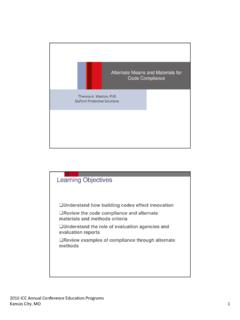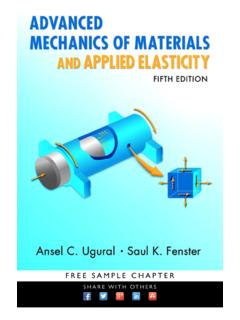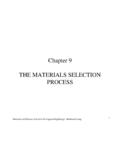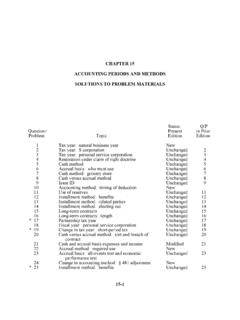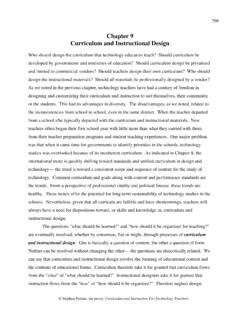Transcription of CHAPTER 2. ELECTROCHEMICAL METHODS AND MATERIALS - GWDG
1 CHAPTER 2. ELECTROCHEMICAL METHODS AND MATERIALS17 CHAPTER 2. ELECTROCHEMICALMETHODS AND ELECTROCHEMICAL Controlled-convection technique: rotating ring disc electrode(RRDE)There are many controlled-convection techniques available but we will restrictour discussion to the two most commonly employed by the electrochemist; the rotatingdisc electrode (RDE) and the rotating ring disc electrode (RRDE). Until the mid-1940s,most physical electrochemistry was based around the dropping mercury , in 1942, V. G. Levich [71] showed that rotating a disc-shaped electrode in aliquid renders it uniformly accessible to diffusion, yet the hydrodynamics of the liquidflow are soluble and the kinetic equations relatively simple. In addition, in contrast tothe case of a stationary planar electrode, the current at an RDE rapidly attains a steadystate value. However, reversal techniques are not available with the RDE as theproducts of the electrode reaction are swept from the disc.
2 However, it is possible tointercept solution-borne intermediates or products in their flight away from the disc, byusing RRDE, see Figure Schematic diagram of a ring disc electrode (see text for details).ELECTROCATALYTIC OXIDATION OF SMALL ORGANIC MOLECULES18 The disc is held at a potential where the reaction of interest takes place, and ancurrent-potential curve is then recorded at the ring. This allows the identification ofintermediates and/or products. A current-potential curve is recorded at the disc while thering potential is held at a constant value where the intermediates or products are reducedor oxidised. This allows the identification of the exact potential range over which theyare formed. Alternatively, the disc is held at a potential where intermediates orpotentials are formed and the ring is maintained at a potential at which they undergoelectron transfer.
3 This allows quantitative kinetic measurements to be essentials of RRDE operation are as for the RDE with the addition of oneextremely important parameter: the collection efficiency (N) could be defined for thereversible reaction:O + e R as:N = IR/ID,( )where IR and ID are the ring current and disc current, respectively, and the negative signindicates that the currents are O is reduced at the disc, even if the ring is set at a potential at which thelimiting current for the re-oxidation of R occurs, not all of the reduced form produced atthe disc will reach the ring surface. For a given system, the fraction of R collected willdepend on the geometry of the disc and ring only. The value of N is given by theAlbery-Bruckenstein equation (see [72] for details), though, in practice, for a particularRRDE cell system, N is determined using a standard redox couple, such as Fe (CN)64 or Br2/Br.
4 A common value of N is ca. The rotation speed provides an independentvariable; increasing decreases the time taken for a species to travel between the discand the ring and hence increases the likelihood of detecting a short lived of the above METHODS critically depend on the species generated at the electrodebeing active towards further electron transfer at the informative example of the application of the RRDE concerns the study ofthe reduction of O2 at a Pt disc electrode and the detection of the intermediates and/orproducts at the Pt ring. The technological importance of oxygen reduction in devicessuch as fuel cells and metal-air batteries has led to an extensive investigation of thereduction mechanism and particularly of the role of hydrogen peroxide (H2O2) as anintermediate species. Distinguishing between these processes has primarily beenCHAPTER 2.
5 ELECTROCHEMICAL METHODS AND MATERIALS19achieved with the rotating ring disc electrode. In O2-saturated solutions, a positivepotential, high enough to oxidise any H2O2 formed at the disc, is applied to the ring andthe concentration of H2O2 in the solution bulk is kept to a minimum. The potential onthe disc is then scanned cathodically and the ring and disc currents simultaneouslymonitored. A second type of experiment can also be carried out in O2 free solutionscontaining H2O2. Now the ring potential is fixed so that all O2 molecules arriving at thering are reduced. Thus, any O2 formed at the disc by disproportionation will be reducedat the ring and a current is ELECTROCHEMICAL impedance spectroscopy ( techniques)Recently, ELECTROCHEMICAL impedance spectroscopy has also been used for thestudy of the mechanistic origin of ELECTROCHEMICAL oscillators such as an active-passivetransition of metal surfaces and electrocatalytic oxidation of C1 to excite an ELECTROCHEMICAL cell by a sinusoidal signal and the analysisof the currents produced were first employed as a way of measuring the rate constantsof fast electron transfer reactions.
6 In any measurement of fast reactions by whatevertechnique, information has to be obtained at short times, otherwise diffusion rather thankinetics becomes the rate determining process. The bridge was for a time the onlyinstrumental technique available to allow measurements on the millisecond time scaleand below, and the basics of present-day techniques and METHODS of analysis wereworked out using an ELECTROCHEMICAL cell at equilibrium as the unknown arm of aWheatstone bridge. Modern instrumentation allows measurements to be made farmore expeditiously than with a manually balanced bridge, thus permitting continuousrecording of parameters under dynamic rather than equilibrium conditions, , incyclic voltammetry or polarographic experiments. At the other end of the time scale, techniques are now important in corrosion studies, where rapid response is oflesser importance than complete analysis of what are often complicated processesinvolving surface and solution the study of ELECTROCHEMICAL systems, ELECTROCHEMICAL impedancespectroscopy (EIS) can give accurate kinetic and mechanistic information with a varietyof techniques and output formats.
7 For this reason, EIS is becoming a powerful tool inELECTROCATALYTIC OXIDATION OF SMALL ORGANIC MOLECULES20the study of corrosion, semiconductors, batteries, electroplating, electro-organicsynthesis and electrocatalysis (see Table ).Research AreaApplicationCorrosionRate determination,Inhibitor and coatings,Passive layer investigationsCoating EvaluationDielectric measurements,Corrosion protectionBatteries/Fuel CellsState-of-charge, MATERIALS selection,Electrode designElectrodepositionSurface pre-treatment,Deposition mechanismElectro-Organic SynthesisAdsorption-desorption,Reaction mechanismSemiconductorsPhotovoltaic workTable Summary of some of the ELECTROCHEMICAL phenomena that have beenstudied using of EIS techniquesSmall amplitude: EIS techniques use very small excitation amplitudes, often in therange of 5 10 mV peak to peak. Excitation waveforms of this amplitude cause onlyminimal perturbation of the ELECTROCHEMICAL test system, reducing errors caused by themeasurement study: Since ELECTROCHEMICAL impedance experiments provide data on bothelectrode capacitance and charge-transfer kinetics, EIS techniques can provide valuablemechanistic 2.
8 ELECTROCHEMICAL METHODS AND MATERIALS21 Measurement accuracy: Since the method does not involve a potential scan, one canmake measurements in low conductivity solutions where techniques are subject toserious potential-control errors. In fact, one can use EIS to determine theuncompensated resistance of an ELECTROCHEMICAL advantages: The main advantage of EIS is that one can use a purelyelectronic model to represent an ELECTROCHEMICAL cell. An electrode interface undergoingan ELECTROCHEMICAL reaction is typically analogous to an electronic circuit consisting of aspecific combination of resistors and capacitors. One can take advantage of this analogyby using an established A. C. circuit theory to characterise the ELECTROCHEMICAL systemin terms of its equivalent practice, an impedance plot obtained for a given ELECTROCHEMICAL system canbe modelled with one or more equivalent circuits.
9 This information can be used toverify a mechanistic origin of the system, or at least to rule out incorrect models. Once aparticular model is chosen, one can correlate physical or chemical properties withcircuit elements and extract numerical values by filtering the data to the circuit Auger electron spectroscopy (AES)If a vacancy is created in an atomic core level, for example, by irradiation withX-rays, as above, or with electrons, then an electron from an upper level can beexpected to fill the hole. Figure is a schematic view of the process in which a K-shell vacancy in silicon is filled by an L1 electron. The energy difference liberated bythis relaxation is 1690 eV, and it can be entirely released in the form of a photon (X-rayfluorescence) by ejecting an Auger electron from the atom. In the example of , the Auger electron comes from the L2, 3 shell.
10 The required energy loss of 1690 eVis divided into the energy required to remove the electron from the sample (mostly itsbinding energy) and the kinetic energy it retains upon entering the vacuum. Since thetotal energy of the transition and the binding energy are well-defined values, the kineticenergy of the Auger electron in vacuo is also well-defined. By measuring thedistribution of electrons vs. kinetic energy, one can obtain a spectrum showing sharpELECTROCATALYTIC OXIDATION OF SMALL ORGANIC MOLECULES22peaks at the discrete Auger energies. Each Auger line is characteristic of the originatingatom and can be used analytically to indicate the presence of that Schematic view of the Auger emission process from silicon. The atom isionised initially by an incident electron. That electron and one from the K-shell leave thesample as energy loss electrons.





